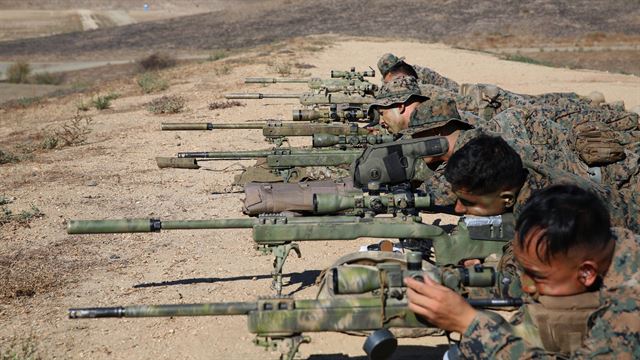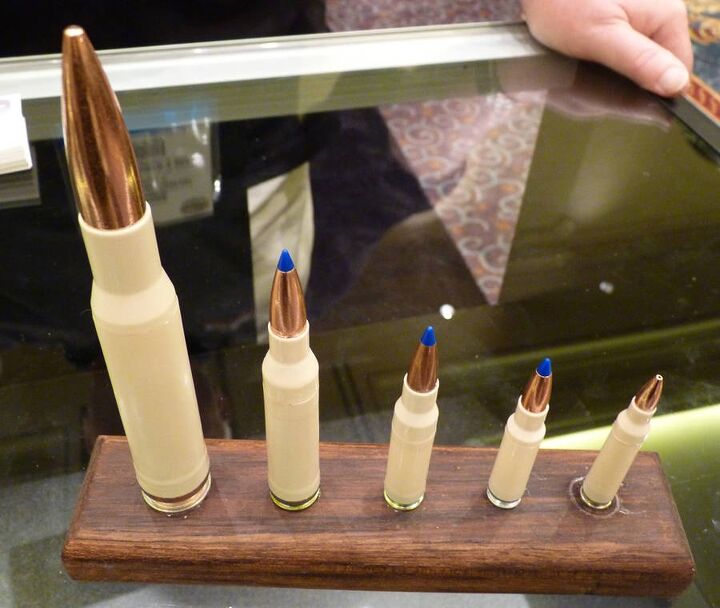It’s nothing new to hear about various plans or queries from the USMC into future small arms programs, but the Marine Corps Times (which actually isn’t associated with the Marine Corps at all) has come out with an article illustrating some of the points that Quantico is looking for in infantry small arms development. Notice I titled this as “intentions” and not “plans” because most of this is still at the proof of concept stage, and certainly not at an RFI yet. Certainly one of the biggest changes to our inventory is the switch to the lighter M4 carbine to replace the M16A4, and that is almost cemented. However, this is a look at some of the other small arms ideas.
Painting rifles is nothing new at all to the infantry. Scout Sniper platoons have been spray painting or “Bo-flauging” as it is known in the community, since the Vietnam era or so. Personally I think any R & D into “special paint” that has “wavelengths invisible to the naked eye” is a almost an absurd notion and seems to come from the desk of someone who hasn’t spent enough time in the field. Regular spray paint works absolutely fine, Sniper platoons and Recon have no issues with it. Usually you’ll paint a rifle for a specific environment, using materials from that environment (pine in woodland, sticks/twigs in desert, etc..). After a while, the paint wears down, you tape up all the essential parts, use some paint thinner to scrape it off, and you repaint it the same style or a different one. All that needs to happen is for the idea of approving unit commanders to allow this within their battalions.
However, adding suppressors aren’t a new idea at all and while they’re a good one, I think the headache would almost not be worth it. This goes along with my philosophy on gear. Take something like the Magpul angled foregrip. Sure, the thing works wonders when shooting, etc… But an Infantry Marine doesn’t spend most of his time shooting, he spends it sleeping, walking, standing post, and going on working parties. Where is the use of an angled foregrip in standing 8 hours of post? If the optimal use of the thing is in shooting, and that grunt only spends maybe 3 percent or less time on a deployment actually firing his weapon, then I would argue that the whole thing is negated. I’d apply that to suppressors as well. If their only value is in a gun fight, then the rest of time we’re going to have Marines constantly worrying about losing serialized gear, dropping it somewhere, etc… In addition to it being another pound to worry about. Maybe if we had a squad’s worth of them at the platoon level, and say that squad is being used in a flanking movement or on a satellite patrol where not revealing their position is crucial to mission success, then sure, we can issue it out for that patrol. Or if a company is going to be in a MOUT situation, they would absolutely be worth it. But in the mean time I’d rather have that extra pound be a thermal optic, or better GPS systems.
The Corps is considering allowing camouflage painted rifles for every Marine and suppressors for rifle squads, Woodburn said. It’s part of an effort to help Marines blend into their surroundings and communicate better. The moves could also give every Marine an “operator” look, although both initiatives are just now being researched.
Driving the effort is the idea to bring rifles in line with the rest of Marine gear. While millions of dollars have been spent developing and fielding Marine Pattern digital camouflage in desert and woodland color schemes, Marines still carry black rifles with a distinctly mechanical shape.
A near-term fix could give commanders the authority to allow Marines to paint their rifles to match the environment to which they’re deploying, Woodburn said. It is something many civilian hunters and members of elite units like Marine Corps Forces Special Operations Command already do. The Army has also authorized the move since 2010, when the service recognized the need for better concealment in Afghanistan.
Some achieve the effect with commercial spray paints, while taking care to properly mask optics and other sensitive parts of a rifle. However, Woodburn said the Marine Corps is working with the Office of Naval Research to develop something that can withstand high temperatures and possibly provide other benefits, like concealment in the non-visible spectrum. That would match efforts already underway to develop camouflage uniforms that can be concealed across the electromagnetic spectrum, preventing the enemy from spotting Marines through optics that pick up on wavelengths invisible to the naked eye
…
More importantly though, Woodburn said, is that they [suppressors] improve command and control within an infantry unit. That is especially important indoors, where the cacophony of a squad clearing rooms can be disorienting and make it nearly impossible to use verbal communications.
.
Plans for an M2A1 are in the mix, with new tripods, barrels that don’t require headspace and timing, and semi polymer ammunition. Most of this technology is or has been out for a while, but typical Marine Corps takes eons over the other services to get it.
For now, Marines will still have to use a gauge to set the headspace and timing whenever they change a barrel. But by late fiscal 2016, upgraded M2A1s will hit the fleet. Full fielding to replace every ground-mounted M2 will be completed by late 2018.
…
The conversion kit will also include a new flash hider that reduces muzzle flash by 50 percent. That will be a welcome relief, particularly for gunners during nighttime engagements when blinding muzzle flash can make it difficult to see targets through night vision goggles.
…
Long-time research efforts into polymer ammunition could also soon yield new lightweight ammunition for the M2. The move could allow Marines to carry 40 percent more ammunition at the same weight they carry now.
In recent months, the Marine Corps completed testing of polymer-cased ammunition that uses extremely durable plastics to form the cartridge’s case in place of traditional brass.
The rest of the article goes on to highlight the current switch to M4s, and plans for the new pistol that tie in with the Army’s competition. Unfortunately, I think the downturn of the article is that some of these changes have been wanted for a while, and others are almost a fantasy that can’t meet reality. Polymer ammunition or at least semi polymer casings still have a good ways to go before being anywhere near ready for military adoption. M2 machine guns without the need to manually headspace and time have also been around for a bit, it’s just that the service doesn’t want to commit the resources to acquire them. Seeing some of these changes take place would be fantastic, but reality is a whole other monster.
 Your Privacy Choices
Your Privacy Choices


